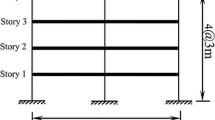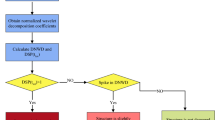Abstract
This article extends a signal-based approach formerly proposed by the authors, which utilizes the fractal dimension of time frequency feature (FDTFF) of displacements, for earthquake damage detection of moment resist frame (MRF), and validates the approach with shaking table tests. The time frequency feature (TFF) of the relative displacement at measured story is defined as the real part of the coefficients of the analytical wavelet transform. The fractal dimension (FD) is to quantify the TFF within the fundamental frequency band using box counting method. It is verified that the FDTFFs at all stories of the linear MRF are identical with the help of static condensation method and modal superposition principle, while the FDTFFs at the stories with localized nonlinearities due to damage will be different from those at the stories without nonlinearities using the reverse-path methodology. By comparing the FDTFFs of displacements at measured stories in a structure, the damage-induced nonlinearity of the structure under strong ground motion can be detected and localized. Finally shaking table experiments on a 1:8 scale sixteen-story three-bay steel MRF with added frictional dampers, which generate local nonlinearities, are conducted to validate the approach.
Similar content being viewed by others
Reference
Canus C, Goncalves P, Guiheneuf B and Vehel JL (2013), Available from: http://fraclab.saclay.inria.fr/ (last accessed 26 March 2013).
Chanpheng T, Yamada H, Katsuchi H and Sasaki E (2012), “Nonlinear Features for Damage Detection on Large Civil Structures due to Earthquakes,” Structural Health Monitoring, 11(4): 482–488.
Doebling SW, Farrar CR, Prime MB and Shevitz DW (1996), “Damage Identification and Health Monitoring of Structural and Mechanical Systems from Changes in Their Vibration Characteristics: a Literature Review,” Report LA-13070-MS, Los Alamos National Laboratory, Los Alamos, NM.
Farrar CR, Worden K, Todd MD, Park G, Nichols J, Adams DE, Bement MT and Farinholt K (2007), “Nonlinear System Identification for Damage Detection,” Report LA-14353S, Los Alamos National Laboratory, Los Alamos, NM.
Hou Z, Noori M and Amand RS (2000), “Wavelet-based Approach for Structural Damage Detection,” Journal of Engineering Mechanics, 126(7): 677–683.
Kalkan E, Fletcher JPB, Leith WS, McCarthy J and Banga K (2012), “Real-time Seismic Monitoring of Instrumented Hospital Buildings,” USGS Fact Sheet 2012-3028, U.S. Geological Survey, Menlo Park, CA.
Li H, Tao D, Huang Y and Bao Y (2013), “A Data-driven Approach for Seismic Damage Detection of Sheartype Building Structures Using the Fractal Dimension of Time-frequency Features,” Structural Control and Health Monitoring, 20(9): 1191–1210.
Loh CH, Mao CH, Chao SH and Weng JH (2010), “Feature Extraction and System Identification of Reinforced Concrete Structures Considering Degrading Hysteresis,” Structural Control and Health Monitoring, 17(7): 712–729.
Masri S, Sassi H and Caughey T (1982), “Nonparametric Identification of Nearly Arbitrary Nonlinear System,” Journal of Applied Mechanics, 49(3): 619–628.
Nagarajaiah S and Basu B (2009), “Output Only Modal Identification and Structural Damage Detection Using Time Frequency & Wavelet Techniques,” Earthquake Engineering & Engineering Vibration, 8(4): 583–605.
Ou J and Li H (2010), “Structural Health Monitoring in Mainland China: Review and Future Trends,” Structural Health Monitoring, 9(3): 219–231.
Pan TC and Lee CL (2002), “Application of Wavelet Theory to Identify Yielding in Seismic Response of Bi-linear Structures,” Earthquake Engineering and Structural Dynamics, 31(2): 379–398.
Park YJ, Ang AHS and Wen YK (1985), “Seismic Damage Analysis of Reinforced Concrete Buildings,” Journal of Structural Engineering, 111(4): 740–757.
PEER Strong Motion Database (2013), Available from: http://peer.berkeley.edu/smcat/data.html (last accessed 26 March 2013)
Qiao L and Esmaeily A (2011), “An Overview of Signal-Based Damage Detection Methods,” Applied Mechanics and Materials, 94: 834–851.
Rice H and Fitzpatrick J (1991), “A Procedure for the Identification of Linear and Non-linear Multi-degree-of-freedom Systems,” Journal of Sound and Vibration, 149(3): 397–411.
Sohn H, Farrar CR, Hemez FM, Shunk DD, Stinemates DW, Nadler BR and Czarnecki JJ (2004), “A Review of Structural Health Monitoring Literature: 1996–2001,” Report LA-13976-MS, Los Alamos National Laboratory, Los Alamos, New Mexico.
Spanos P, Giaralis A and Politis N (2007), “Time-frequency Representation of Earthquake Accelerograms and Inelastic Structural Response Records Using the Adaptive Chirplet Decomposition and Empirical Mode Decomposition,” Soil Dynamics and Earthquake Engineering, 27(7): 675–689.
Todorovska MI and Trifunac MD (2007), “Earthquake Damage Detection in the Imperial County Services Building I: The Data and Time-frequency Analysis,” Soil Dynamics and Earthquake Engineering, 27(6): 564–576.
Wu M and Smyth AW (2007), “Application of the Unscented Kalman Filter for Real-time Nonlinear Structural System Identification,” Structural Control and Health Monitoring, 14(7): 971–990.
Author information
Authors and Affiliations
Corresponding author
Additional information
Supported by: National Natural Science Foundation under Grant No. 51161120359, Ministry of Education under Grant No. 20112302110050 and Special Fund for Earthquake Scientific Research in the Public Interest under Grant No. 201308003
Rights and permissions
About this article
Cite this article
Tao, D., Mao, C., Zhang, D. et al. Experimental validation of a signal-based approach for structural earthquake damage detection using fractal dimension of time frequency feature. Earthq. Eng. Eng. Vib. 13, 671–680 (2014). https://doi.org/10.1007/s11803-014-0271-8
Received:
Accepted:
Published:
Issue Date:
DOI: https://doi.org/10.1007/s11803-014-0271-8




